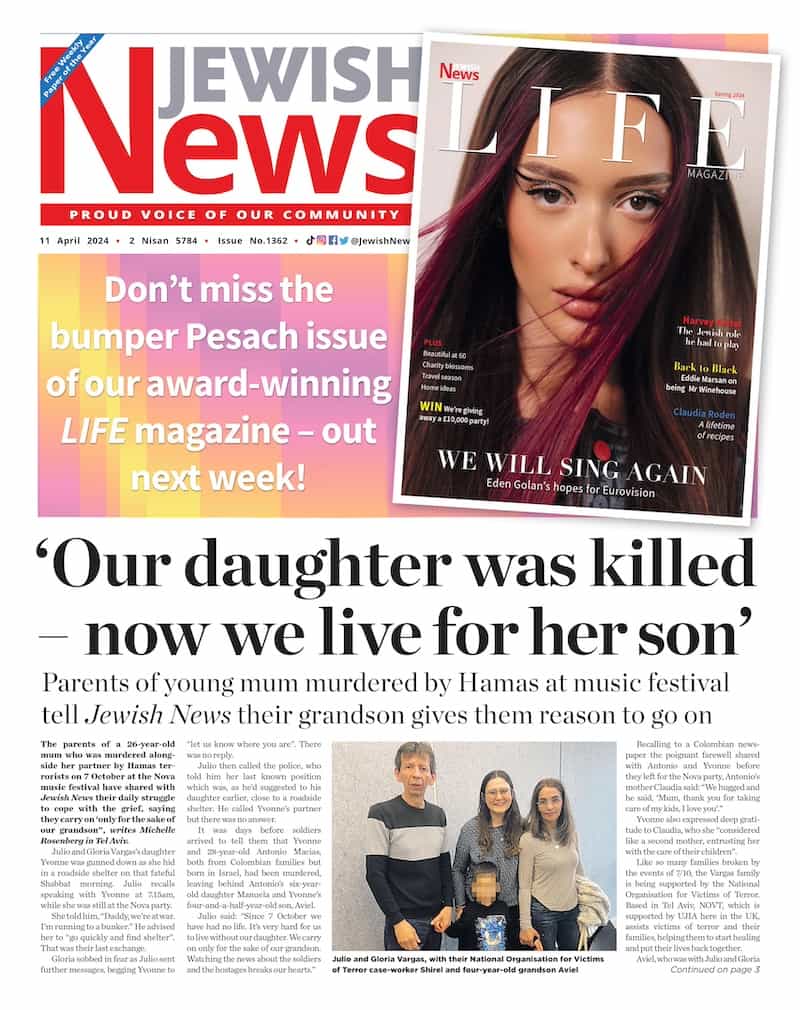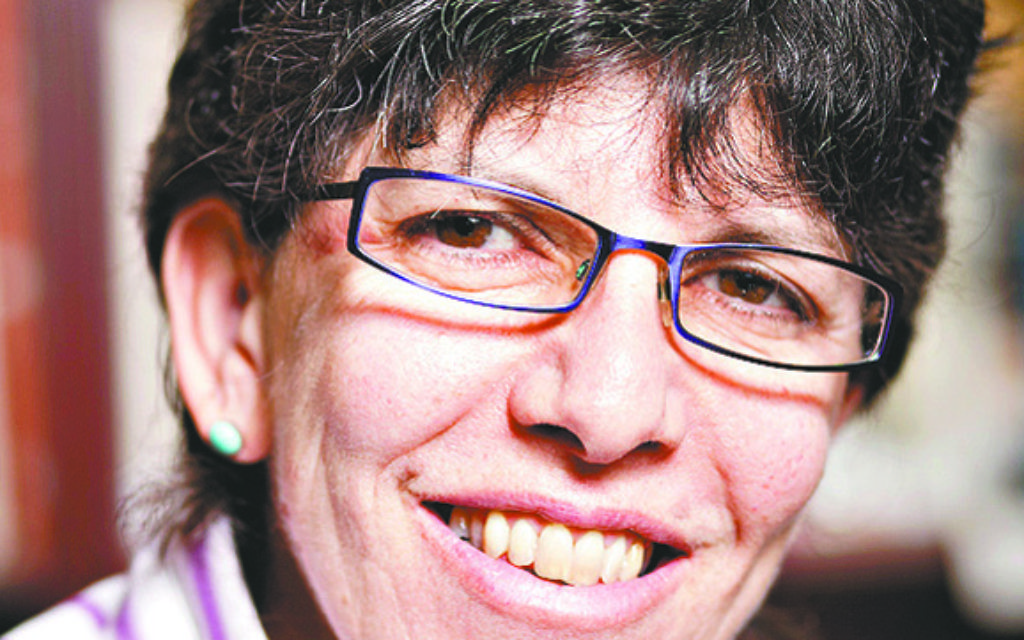OPINION: LGBTQIQ Jews Under the Rainbow
By Rabbi Elizabeth Tikvah Sarah of Brighton and Hove Progressive Synagogue
- If you are interested in contributing to the Jewish News LGBT section, please contact the online editor: jackm@thejngroup.com

Pride. Nowadays, all you have to do is say the word, and people immediately recognise it as shorthand for ‘LGBT Pride’.
So, what is LGBT?
Get The Jewish News Daily Edition by email and never miss our top stories Free Sign Up
On lesbian and gay pride demonstrations in the 1970s and early 1980s, the most common badge on display was the ‘pink triangle’ – in memory of the persecution of gay men by the Nazis (find out more information HERE.). And then, by the late 1980s the ‘rainbow flag’, first designed in 1978 by Gilbert Baker of San Francisco (which you can read about HERE) , had become the dominant emblem, proclaiming, an alliance of solidarity, encompassing ‘lesbian’, ‘gay’, ‘bisexual’ and ‘transgender’ people – hence: LGBT.
While ‘bisexual’ challenges binary assumptions concerning sexual orientation, the inclusion of ‘transgender’ acknowledges the more fundamental issue of gender.
For years, lesbians and gay men had been asserting that being lesbian and gay was not just about who you ‘slept with’, and had been presenting ourselves in ways that challenged binary ‘female’/’male’ gender stereotypes. Now, those whose main concern was gender rather than sexuality were coming to the fore.
Since the 1967 Sexual Offences Act decriminalised ‘homosexual acts’ between two consenting males over the age of 21 in private, and the progressive lowering of the ‘gay’ age of consent from 21, to 18 (1994), to 16 (2000), new laws have recognised the transgender phenomenon – principally, the 2004 Gender Recognition Act, which provides a mechanism to enable trans people to obtain recognition of their preferred gender.
More recently, the 2010 Equality Act makes it unlawful to discriminate against someone in employment and the provision of goods, services, housing and facilities because they are intending to undergo, are undergoing, or have undergone gender reassignment.
Just as the 2005 Civil Partnership Act and now the 2013 Marriage (Same-Sex Couples) Act, both reflect and reinforce the increasing social recognition of lesbian and gay relationships, the same can be said of the legal acknowledgement and protection of trans people.
But transgender is more complex than many realise. On one level, transgender refers, simply, to those who make the decision to transition from the gender assigned to them at birth to the gender with which they identify. But while those transitioning undergo hormone treatment, they don’t always choose surgical adjustment.

Further, since the 1990s, the emergence of a ‘queer’ consciousness has been challenging gender binary tyranny. In recognition, of those of varying sexualities and genders, who consider themselves primarily as, ‘gender queer’ or ‘variant’, LGBT has been extended to encompass ‘Q’. The rainbow umbrella has also been extended further to include those who are ‘intersex’ in their internal and/or external sexual characteristics – hence: LGBTQI.
The notion of an ever more encompassing rainbow – recently extended even further, with an extra, ‘Q’ to acknowledge those who are ‘questioning’ of their gender and/or sexuality – is very cheering.
Until you become aware of the extent of homophobia and transphobia – which, if anything, has increased, in response to the heightened visibility of LGBTQIQ people.
In recent years, November 20 has been designated as Transgender Day of Remembrance (TDOR) in honour of Rita Hester, a transgender woman of colour, who was murdered in her home in Allston, Mass., USA, on November 28, 1998. 
Human Rights Campaign, which works for lesbian, gay, bisexual and transgender rights, states on its website: ‘TDOR … provides a forum for transgender communities and allies to raise awareness of the threat of violence faced by gender variant people and the persistence of prejudice felt by the transgender community. Communities organize events and activities including town hall style “teach-ins,” photography and poetry exhibits and candlelit vigils. These activities make anti-transgender violence visible to stakeholders like police, the media and elected officials.’ You can read more about this HERE.
Originating in the USA, TDOR will be marked in towns and cities across that nation. It has also gone global, and events have been organised in the UK, in Brighton, Croydon, Coventry and Edinburgh, in Ontario, Canada, Umea, Sweden – and in Tel Aviv, Israel, at the LGBT centre in Meir Garden.
Of course, TDOR will not be commemorated in the 81 countries that continue to criminalise LGBT people – including, 37 African nations, 22 nations of the Middle East and Asia, 11 nations in the Americas, and 10 nations in Oceania.
In addition, while not outlawing ‘homosexuality’, in 2013, Russia enacted an ‘anti-gay propaganda law’ which you can read about HERE – updated in June 2014 to a list of 81 countries).
So, LGBTQIQ: A tale of progress and inclusion; and also a story of continuing persecution – and not just in those places where persecution is enshrined in the law. For statistics on homophobic, biphobic and transphobic hate crimes in ‘progressive’ London, HERE.
In October 2012, the Rainbow Jews project was launched with support from Liberal Judaism and funding from the Heritage Lottery.

Recording Jewish LGBT history from the 1950s to today, the project has produced a film, an exhibition and educational materials which can be seen HERE.
There are some who think that there is nothing in Jewish teaching that acknowledges LGBT life. I would refer these people to www.transtorah.org – and also to, for example, the discussions of ‘intersex’ by the sages, which amount to hundreds of references in the Mishnah and Talmud alone (e.g. Mishnah Bikkurim 4:5), and to the volume of Torah commentaries, Torah Queeries, edited by Greg Drinkwater, Joshua Lesser and David Shneer (New York University Press, 2009).
On the theme of the Torah: In December, the Torah-reading cycle will turn to the four-portion-long saga of Joseph (Genesis 37-50) and his special coat – k’tonnet passim – which is clearly designated as the ‘garment of a Princess’ elsewhere in the Bible (Second Book of Samuel 13:18).
The figure of Joseph, presented as ‘beautiful of form and beautiful in appearance’ (Gen. 39:6), just like his mother Rachel (Gen. 29:17), invites us to question our gender assumptions. As they say, ‘there is nothing new under the sun’ – and there is only one sun that shines on us all, LGBTQIQ and heterosexual, Jews and non-Jews alike.
It’s just a question of opening our hearts and minds and transforming our perspective.

Thank you for helping to make Jewish News the leading source of news and opinion for the UK Jewish community. Today we're asking for your invaluable help to continue putting our community first in everything we do.
For as little as £5 a month you can help sustain the vital work we do in celebrating and standing up for Jewish life in Britain.
Jewish News holds our community together and keeps us connected. Like a synagogue, it’s where people turn to feel part of something bigger. It also proudly shows the rest of Britain the vibrancy and rich culture of modern Jewish life.
You can make a quick and easy one-off or monthly contribution of £5, £10, £20 or any other sum you’re comfortable with.
100% of your donation will help us continue celebrating our community, in all its dynamic diversity...
Engaging
Being a community platform means so much more than producing a newspaper and website. One of our proudest roles is media partnering with our invaluable charities to amplify the outstanding work they do to help us all.
Celebrating
There’s no shortage of oys in the world but Jewish News takes every opportunity to celebrate the joys too, through projects like Night of Heroes, 40 Under 40 and other compelling countdowns that make the community kvell with pride.
Pioneering
In the first collaboration between media outlets from different faiths, Jewish News worked with British Muslim TV and Church Times to produce a list of young activists leading the way on interfaith understanding.
Campaigning
Royal Mail issued a stamp honouring Holocaust hero Sir Nicholas Winton after a Jewish News campaign attracted more than 100,000 backers. Jewish Newsalso produces special editions of the paper highlighting pressing issues including mental health and Holocaust remembrance.
Easy access
In an age when news is readily accessible, Jewish News provides high-quality content free online and offline, removing any financial barriers to connecting people.
Voice of our community to wider society
The Jewish News team regularly appears on TV, radio and on the pages of the national press to comment on stories about the Jewish community. Easy access to the paper on the streets of London also means Jewish News provides an invaluable window into the community for the country at large.
We hope you agree all this is worth preserving.
-
By Laurent Vaughan - Senior Associate (Bishop & Sewell Solicitors)
-
By Laurent Vaughan - Senior Associate (Bishop & Sewell Solicitors)
-
By Laurent Vaughan - Senior Associate (Bishop & Sewell Solicitors)
-
By Laurent Vaughan - Senior Associate (Bishop & Sewell Solicitors)






















